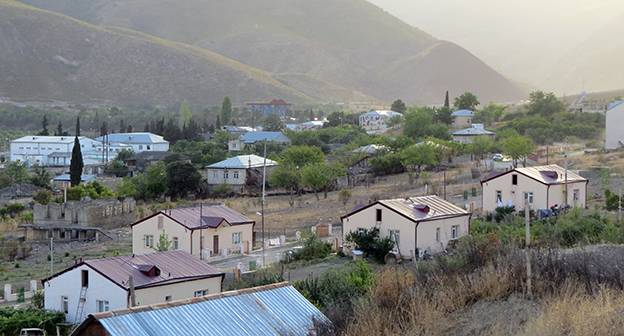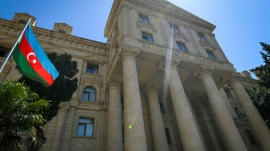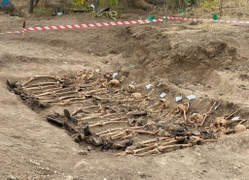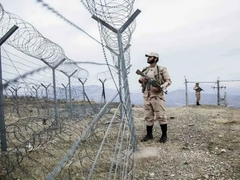Azerbaijan's armed forces Saturday have liberated eight villages including the strategic Madagiz settlement in the Tartar district of Azerbaijan on the seventh day of the fierce clashes with Armenia.
The country's President Ilham Aliyev announced the liberation of the villages in two separate posts published to his official Twitter account on the evening of October 3.
"Today Azerbaijan's army hoisted our flag over Madagiz. Madagiz is ours. Karabakh is Azerbaijan," reads the post.
"The Azerbaijani Army today liberated Talish village of Tartar district, Mehdili, Chakhirli, Ashaghi Maralyan, Shaybay and Guyjag villages of Jabrayil district and Ashaghi Abdurrahmanli village of Fuzuli district. Karabakh is Azerbaijan!" the next post reads.
On the same day, President Aliyev announced that he reinstates the historical Azerbaijani name of Madagiz and as of October 3, 2020, the settlement is called Sugovushan.
Sugovushan is a village in the Tartar district of Azerbaijan, 332 kilometer west of the capital Baku. It was part of the Aghdara district in the former Nagorno-Karabakh Autonomous Oblast of the Azerbaijan Soviet Socialist Republic. Following Armenia's military campaign to occupy Azerbaijan's Nagorno-Karabakh region after the dissolution of the Soviet Union in 1991, the parliament of Azerbaijan revoked the special status of Aghdara in 1992 and ordered the allocation of its territory to Tartar, as well as to the currently occupied Aghdam, and Kalbajar districts.
The Saint Yelisey monastery that consists of seven churches and was founded during the reign of the ancient Azerbaijani state of Caucasian Albania in the fifth century locates in Sugovushan. Caucasian Albania existed in the territory of Azerbaijan from the 6th century BC to the 8th century AD and was unrelated to modern-day Albania.
Armenia's forces occupied Sugovushan during the war in the Nagorno-Karabakh region of Azerbaijan in 1994 and deployed military units there after the occupation. The military unit № 49971 in the village was said to be one of the strongest footholds of Armenia in the occupied Azerbaijani territories. Moreover, the military unit № 33651, known as "the sixth defense district" of the Armenian troops was also stationed in Sugovushan.
The armed forces of Azerbaijan liberated the strategic village as part of the counter-attack campaign that was launched on September 27 to repel Armenia's offensive. Heavy shelling of Azerbaijan's military and civilian settlements by Armenia's troops catapulted the fiercest clashes between the sides since 2016.
Azerbaijani authorities reported about 22 civilian deaths and 74 injuries in the wake of Armenia's shelling of Azerbaijani civilian settlements, while did not reveal a number for military casualties. Armenia's military death toll is 207, according to data compiled by Yerevan. However, the Defense Ministry of Azerbaijan revealed that around 2,300 servicemen of the Armenian army have died and wounded during the battles.
Meanwhile, Paul Ronzheimer, a war journalist of the German Bild newspaper wrote on his Twitter account that the casualties of Armenia are around 4,000. Ronzheimer traveled this week to Armenia for monitoring closely the current situation in the occupied Nagorno-Karabakh region of Azerbaijan.
The Armenia-Azerbaijan Nagorno-Karabakh conflict is one of the world's and region's oldest conflicts. It has been jeopardizing regional security since the hostilities broke out in the early 1990s after Armenia launched a full-fledged military campaign against Azerbaijan. The rising anti-Azerbaijan sentiments in Armenia grew into armed intervention in Azerbaijan's internationally recognized borders following the dissolution of the USSR in 1991.
The bloody war in 1991-1994 resulted in Armenia occupying 20 percent of Azerbaijan’s internationally recognized territories – the Nagorno-Karabakh region and seven surrounding districts, including Lachin, Kalbajar, Aghdam, Fuzuli, Jabrayil, Gubadli, and Zangilan. The humanitarian crisis of the war for Azerbaijan was the killing of 30,000 of its citizens and the displacement of one million. Armenia has intensively been settling the occupied lands with ethnic Armenians. Today, there is no single ethnic Azerbaijani living in those territories.
The UN Security Council's four resolutions demanding the immediate withdrawal of the occupying forces from the Azerbaijani lands go unfulfilled to date.
Over the past decade, major armed skirmishes between Armenian and Azerbaijani troops, including in April 2016 and in July 2020, have claimed dozens of lives on both sides.







 The Azerbaijani government has rejected the recent claims made by French Interior Minister Gérard Darmanin, who accused Baku of fostering separatis...
The Azerbaijani government has rejected the recent claims made by French Interior Minister Gérard Darmanin, who accused Baku of fostering separatis...
 The Chief of the Atomic Energy Organisation of Iran (AEOI) said that the country has allowed more than 130 inspectors of the International Atomic E...
The Chief of the Atomic Energy Organisation of Iran (AEOI) said that the country has allowed more than 130 inspectors of the International Atomic E...
 Maria Zakharova, the spokeswoman for the Russian Foreign Ministry, has firmly stated that Russia categorically rejects any suggestion of exchanging...
Maria Zakharova, the spokeswoman for the Russian Foreign Ministry, has firmly stated that Russia categorically rejects any suggestion of exchanging...



